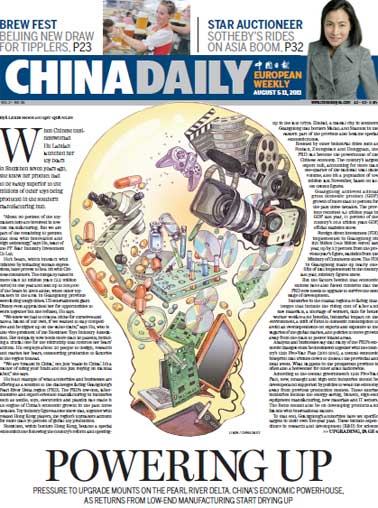Powering up
Updated: 2011-08-05 11:35
By Alexis Hooi and Qiu Quanlin (China Daily)
Pressure to upgrade mounts on the Pearl River Delta, China's economic powerhouse, as returns from low-end manufacturing start drying up
When Chinese businesswoman Hu Lantian launched her toy bears in Shenzhen seven years ago, she knew her product had to be vastly superior to the millions of other toys being produced in the southern manufacturing hub.
|
 Hu Lantian, head of the PP Bear Industry Investment Co. [Qiu Quanlin/China Daily] |
"About 90 percent of the toymakers here are involved in low-cost manufacturing. But we are part of the remaining 10 percent that deal with innovation and high technology," says Hu, head of the PP Bear Industry Investment Co Ltd.
Hu's bears, which interact with children by imitating human expressions, have proven to be a hit with Chinese consumers. The company raked in more than 20 million yuan (2.2 million euros) in one year and sold up to 300,000 of the bears in 2008 alone, when other toymakers in the area in Guangdong province were facing tough times. US entertainment giant Disney even approached her for opportunities to work together but she refused, Hu says.
"We knew we had to create a niche for ourselves and have a brand of our own, if we wanted to stay competitive and be higher up on the value chain," says Hu, who is also vice-president of the Shenzhen Toys Industry Association. Her company now holds more than 20 patents, including a crucial one for the microchip that controls her bears' actions. Hu employs about 20 people to design, research and market her bears, outsourcing production to factories in the region instead.
|
||||
Hu is an example of what authorities and businesses are offering as a solution to the challenges facing Guangdong's Pearl River Delta region (PRD). The PRD's low-cost, labor-intensive and export-oriented manufacturing in industries such as textile, toys, electronics and plastics has made it an engine of China's economic growth in the past three decades. Toy industry figures alone show that, together with related Hong Kong players, the region's toymakers account for more than 70 percent of global toy production.
Shenzhen, which borders Hong Kong, became a special economic zone following the country's reform and opening-up in the late 1970s. Zhuhai, a coastal city in southern Guangdong that borders Macao, and Shantou in the eastern part of the province also became special economic zones.
Boosted by other industrial cities such as Foshan, Zhongshan and Dongguan, the PRD has become the powerhouse of the Chinese economy. The country's largest export hub, accounting for more than one-quarter of the national total trade volume, also hit a population of 104 million last November, based on latest census figures.
Guangdong achieved annual gross domestic product (GDP) growth of more than 10 percent for the past three decades. The province recorded 4.5 trillion yuan in GDP last year, 11 percent of the country's 39.8 trillion yuan GDP, official statistics show.
Foreign direct investment (FDI) implemented in Guangdong hit $21 billion (14.8 billion euros) last year, up by 3.7 percent from the previous year's figure, statistics from the Ministry of Commerce show. The FDI in Guangdong made up nearly one-fifth of that implemented in the country last year, ministry figures show.
But the factors behind that economic success have also fueled concerns that the PRD now needs to upgrade to survive the next stage of development.

Industries in the coastal region are facing challenges that include the rising cost of labor and raw materials, a shortage of workers, calls for better worker welfare and benefits, industrial impact on the environment, a shift of focus to domestic consumption to avoid an overdependence on exports and exposure to the vagaries of the global market, and policies to move growth away from the coast to poorer inland areas.
Analysts and businesses say that many of the PRD's economic changes must be considered together with the country's 12th Five-Year Plan (2011-2015), a central economic blueprint that trickles down to those at the provincial and local levels. What happens in the prosperous province is often also a bellwether for other areas nationwide.
According to the central government's 12th Five-Year Plan, new, strategic and high-tech industries should be developed and supported by policies to wean the economy away from previous production models. These sunrise industries include the energy-saving, biotech, high-end equipment manufacturing, new materials and IT sectors. The focus should also be on developing products and brands with international stature.
To that end, Guangdong's authorities have set specific targets in their own five-year plan. These include expenditure in research and development (R&D) for science and technology taking up 2.3 percent of the targeted 6.68 trillion-yuan provincial GDP by 2015, up from the 1.8 percent allocated for last year. Patents filed for every 1 million people should hit 520 by the end of the period, up from the 380 applications targeted for 2010.
E-paper

Double vision
Prosperous Hangzhou banks on creative energies to bridge traditional and modern sectors
Minding matters
A touch of glass
No longer going by the book
Specials

Ancient plate broken
An ancient porcelain plate was accidentally destroyed during a research in the Palace Museum.

Selfless actions
A 20-year-old girl becomes an Internet star for giving her first kiss to a drowning old man.

Space race
Homebuyers are learning the hard facts of supply and demand: too many cars and too few parking spaces.




